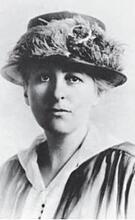Pauline Goldmark
Pauline Goldmark’s talents as a researcher made her indispensable to labor rights initiatives. A National Consumers’ League board member for 40 years, Goldmark lobbied to shift public policy on worker safety and child labor. During that time, she helped compile statistics and evidence for legal action, including the 1908 Supreme Court case Muller v. Oregon, which led to a court decision limiting the workday. Among other important work, Goldmark wrote investigative reports on the New York State Department of Labor’s Industrial Board, was appointed associate director of what became Columbia’s School of Social Work and its Bureau of Social Research, and served as a consultant to the American Telephone and Telegraph Company on employment and health issues for women workers.
Article
Pauline Goldmark was a social worker and activist, part of a group of women seeking the vote and reforms of the urban and industrial excesses of the early twentieth century. A major method of social reformers was to investigate, accumulate facts, present these to the public and lawmakers, and assume that, once educated, the public and legislators would enact the desired changes. Goldmark pioneered in methods of social research central to these reform efforts.
Born February 21, 1874, Pauline was the ninth of ten children of Polish and Czech Jewish immigrants, Joseph and Regina (Wehle) Goldmark. She graduated from Bryn Mawr in 1896 and studied two more years at Columbia. First a volunteer, she became assistant, then executive, of the New York State chapter of the National Consumers’ League (1896–1909). She served for forty years on its national board. The league mobilized the purchasing power and social power of middle-class consumers, mainly women, to buy only goods produced under decent working conditions. They supported legislation regulating child labor, maximum working hours, and minimum working conditions.
Goldmark was appointed associate director of the New York School of Philanthropy, now the Columbia University School of Social Work, and its Bureau of Social Research, while serving on the New York State Department of Labor’s Industrial Board, which studied workforce conditions and monitored enforcement (1913–1915), and the New York State Factory Investigating Commission, created to investigate the infamous Triangle Shirtwaist Fire, where 125 women workers died. Two commission reports were written by Goldmark. During World War I, she served as executive secretary of the United States Department of Labor’s Commission on Women in Industry. From 1918 to 1920, she managed the Women’s Service Section of the U.S. Railroad Administration, supervising the work of over a hundred thousand women workers. She worked closely with many associated with Lillian Wald and the Henry Street Settlement, including Florence Kelley, Frances Perkins, Maud Nathan, Grace and Edith Abbott, her sister, Josephine Goldmark, and others active in the Progressive movement.
She wrote or oversaw many publications on the conditions that women faced entering in ever-larger numbers the unregulated workplaces of the time. When Florence Kelley sought the help of Goldmark’s brother-in-law, Louis Brandeis, to test the constitutionality of the Oregon law on maximum hours of work for women, the famous Brandeis Brief was born. He described it as three pages of law and one hundred pages of facts—social, economic, and medical. In a period of two weeks, Pauline, her sister Josephine, Florence Kelley, and a number of volunteers assembled those one hundred pages to build a powerful indictment of the harmful effects of long hours and bad working conditions upon women, their families, health, and efficacy as workers. In Muller v. Oregon, the Supreme Court abandoned its prior policy of the primacy of private property rights and declared that the state had a supervening right to protect citizens from harmful conditions.
Goldmark served as assistant director of research, under Mary Van Kleek, for the Russell Sage Foundation and then for twenty years, from 1919, was a consultant to the American Telephone and Telegraph Company on employment and health issues of their women workers. She died on October 18, 1962, in Hartsdale, New York.
Selected Works
“Art Work in Tenements.” Survey 26 (April 15, 1911): 114–115
“Child at Work.” Survey 45 (January 22, 1921): 604–605.
“Child Labor in Canneries.” Annals of the American Academy of Political Science 35, Supp. (March 1910): 152–154.
“Facts as to Women in War Industries.” New Republic 13 (December 29, 1917): 251–252.
The Longshoremen, with Charles Brinton Barnes (1915).
“Preliminary Report of the Factory Investigating Commission” (1912; second report, 1913).
“Waste of Overwork.” Independent 90 (April 28, 1917): 210.
West Side Studies (1914).
“Women Conductors.” Survey 40 (June 29, 1918): 369–370.
“Women in the Railroad World.” Annals of the American Academy of Political Science 86 (November 1919): 214–221.
American Women in 1935–1940. Edited by Durwood Howes (1981).
Biographical Dictionary of Social Welfare in America. Edited by Walter Trattner (1986).
Goldmark, Josephine. The Impatient Crusader (1953).
Obituary. NYTimes, October 20, 1962, p. 25.




